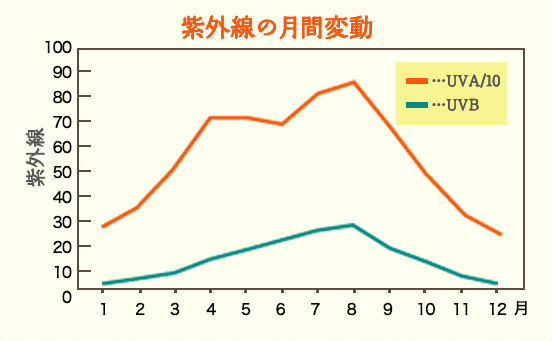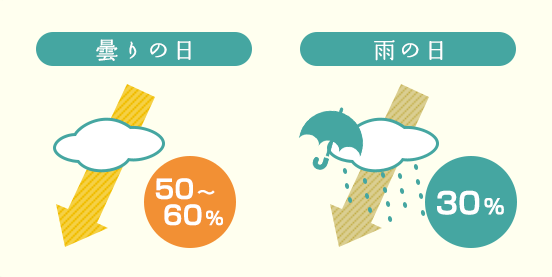
-
Q1
Do you know two types of sunburn?
A1
There are two types of tan: a “Sunburn”, which turns skin red a few hours after being exposed to UV rays, and a “Suntan”, which turns skin black for several weeks to months after the red tan has disappeared. A “Suntan” lasts from several weeks to months.
Source: Health Insurance Manual 2015, Ministry of the Environment -
Q2
It's baking hot in the sun! This can give me a bad sunburn, right?
A2
Because of infrared rays, we feel the heat. Sunburn is caused by the effects of UV rays which are invisible to our eyes and don't make us feel the heat like infrared rays. UV rays are around not only in midsummer but also on cloudy days and even in winter. It is necessary to take UV measures all year round because we can't feel those.
-
Q3
In the first place, what is ultraviolet rays?
A3
UV rays are a type of sunlight that doesn't make you feel heat or glare. They are one of the causes of spots, freckles, and skin aging. They're around all year round regardless of the temperature, weather, or seasons, although the strength varies.
UVA is also called “lifestyle related UV rays” and reaches the “dermis layer” by passing through the epidermis. Darkens the skin immediately and causes the lack of the skin elasticity and moisture over time, which gives spots and wrinkles.
UVB is also called “leisure UV rays”, and due to the effect of UVB, the skin turns red when exposed to UV rays.
By giving damages to the epidermis, it activates the formation of melanin which causes spots and freckles. -
Q4
In the first place, what do SPF and PA represent?
A4
SPF shows how long the tanning by UV-B can be delayed.
For example, if a person whose skin turns red in 30 minutes in the sunlight applies SPF20
sunscreen, then in theory as below:
SPF20… 20 × 30 = 600 minutes
Thus, it can delay sunburn for 600 minutes.
PA is the index of preventing UVA.
PA+: Having a UV-blocking effect
PA++: Having a High UV-blocking effect
PA+++: Having a Super High UV-blocking effect
PA++++: Having an Extremely High UV-blocking effect
To cut the UV rays more thoroughly, it is important to use a moderate amount and reapply frequently. -
Q5
What amount of sunscreen is sufficient?
A5
When using a sunscreen cream, firstly apply the amount of a pearl-size to the entire face. It is more effective to apply the same amount again after that. As for sunscreen gel, apply the same size as one cent coin twice.
Apply enough on the head of the nose that is easily exposed to UV rays. Also, don't forget to apply it to your eyelids!
Source: Health Insurance Manual 2015, Ministry of the Environment -
Q6
Do I need to reapply the sunscreen after the morning care?
A6
Leaving it on without reapplying causes inadvertent sunburn. The indications of SPF and PA are only references.
It greatly depends on the actual use scenes, sensitivity to UV rays, sweat and sebum conditions, etc. It is important to reapply a sunscreen frequently to use it effectively against UV rays. -
Q7
What does “non-chemical” mean?
A7
There are two kinds of ingredients against UV rays: “UV absorbers” and “UV scattering agents”. In rare cases, “UV absorbers” would cause allergic reactions. Meanwhile, it is said that “UV scattering agents” hardly cause allergies. In the SHIGAISEN YOHOU series, sunscreens that aren't using UV absorbers are available as “Non Chemical series”.
If you are looking for a sunscreen that is more gentle on your skin, please try it.
find non-chemical items -
Q8
Is it okay to start the care against UV rays from summer?
A8
People tend to think that “UV measures are for midsummer”.
However, the amount of UV rays starts to increase sharply in March, and they get the strongest from June to August.
Doing the care against UV rays throughout the year is ideal, however, it is necessary to pay special attention from early spring to summer.
-
A9
Don't we need sunscreen on rainy or cloudy days?
Q9
You are still exposed 50~60% of sunny day's UV rays on cloudy days, and about 30% on rainy days.
Remember the protection against UV rays, regardless of the weather!
-
Q10
Don't we need to worry about UV rays in our childhood?
A10
People actively play outside during childhood to high school days. It is said that most of the UV rays we are exposed in our lives will be received by the age of 18. UV rays that have been accumulated since childhood should cause spots, wrinkles, and skin problems after years.
If you would frequently take care of UV measures for your children, they may be grateful to you to say “Thank you mom!”, when they grew up.






